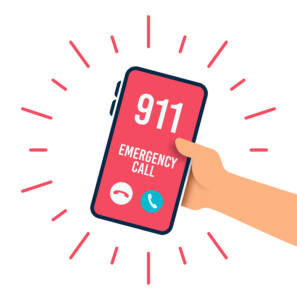What’s the buzz about E911?

What is E911 and should you be worried about it?
 As mobile phone makers, we’re often asked if our phones are “E911 compliant.” We’d like to take a minute and provide a bit of background to help answer that question.
As mobile phone makers, we’re often asked if our phones are “E911 compliant.” We’d like to take a minute and provide a bit of background to help answer that question.
There’s a piece of legislation called the RAY BAUM’S ACT, which applies to “Multi-Line Telephone Service (MLTS)” providers, such as PBX and UCaaS service providers. This legislation calls for these providers to deliver what’s called a “Dispatchable Location” when a 911 call comes from one of their systems. That’s the “compliance” in question.
For reference, without this “dispatchable location,” when you call 911 from a multi-line telephone system, it may go out with only the Automatic Number Identifier (ANI) of the main number, or your main corporate switchboard line, not the phone number or extension that actually dialed 911. The call goes to the public telephone network, then on to the Public Safety Answering Point (PSAP) that responds to 911 calls.
The PSAP system then takes that main number ANI and queries a database for the location of that number. But, because the call only went out with the ANI of the main corporate line, they may just get back your main corporate street address as the address but nothing more specific, like floor number or cubicle location.
Why is this a problem? Well, in emergency situations, every second counts. So, if the 911 caller is having a heart attack, and uses their Wi-Fi mobile phone to call 911 from the office, the call goes to the nearest Wi-Fi Access Point in the building, then to the PBX, then to the public telephone network, and on to the PSAP. This does not provide truly precise location information, as the access point may be some distance away from the caller. This means that the first responders would know the caller is somewhere in the building, but not necessarily which floor or cubicle, or even which business in a shared building environment.
This new “E911” compliance requirement is meant to correct that problem. Under this new requirement, the PBX/UCaaS provider must put technology in place to recognize that someone is calling 911 from their office mobile phone, that they are calling from a specific phone number and not just the main corporate line, which is assigned to an employee in a specific location, like the 2nd floor, west side, instead of just showing up as the main business number and the building address. And, the provider must also predetermine the description of the dispatchable address, for example “2nd floor, west side,” and ensure that information is in the 911 database. This change means that when the PSAP queries the phone number to get the location, they see 2nd floor, west side, and can provide the first responders with that level of detail to respond to the call as quickly as possible saving valuable time in an emergency searching for the distressed caller.
There are companies that offer comprehensive “Enterprise 911” services which do exactly that. These companies can work with PBX/UCaaS providers and building owners to map out all of the Wi-Fi coverage within the building, assign “dispatchable addresses” to each location in the building and manage the process of getting that information in to the public safety location databases.
So, what does that mean as far as Spectralink devices being “compliant” with these E911 regulations?
 Spectralink Wi-Fi products already support the most common approach for handling E911 location identification by providing specific information to the PBX. This approach uses a standards-based component of the SIP contact header known as GRUU (Globally Routable User-Agent URI). This field adds the phone’s MAC address to the contact header so the PBX/UCaaS system can use the MAC address to determine the device location using information from the WLAN system. This often requires the use of an Enterprise 911 solution to perform the cross-referencing, but is highly dependent on your PBX/UCaaS system.
Spectralink Wi-Fi products already support the most common approach for handling E911 location identification by providing specific information to the PBX. This approach uses a standards-based component of the SIP contact header known as GRUU (Globally Routable User-Agent URI). This field adds the phone’s MAC address to the contact header so the PBX/UCaaS system can use the MAC address to determine the device location using information from the WLAN system. This often requires the use of an Enterprise 911 solution to perform the cross-referencing, but is highly dependent on your PBX/UCaaS system.
Another method is to use Real-Time Location Services (RTLS) to provide device location for the mobile client. This approach requires the use of an RTLS platform to track devices and report those locations to the PBX/UCaaS systems. If used on our devices, this also requires an app being installed on Spectralink Versity handsets but is supported natively by the Spectralink 84 Series handset.
Bottom line, our phones can operate just like any other VoIP phones on a PBX or UCaaS system, and we’re happy to work with customers, their PBX/UCaaS provider, and any of the Enterprise 911 companies they may have chosen. It’s a win-win-win for everyone involved!
For more information about E911 or any of our enterprise products, please contact info@spectralink.com.
